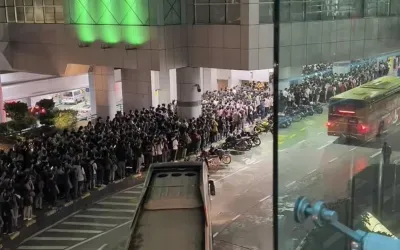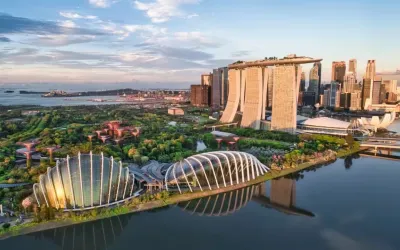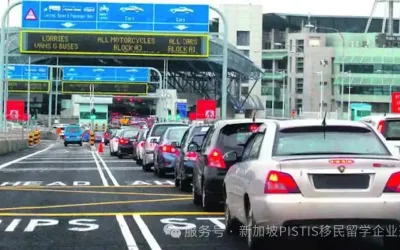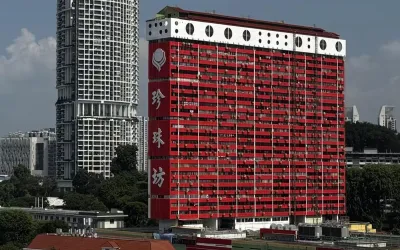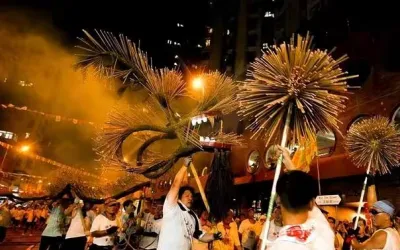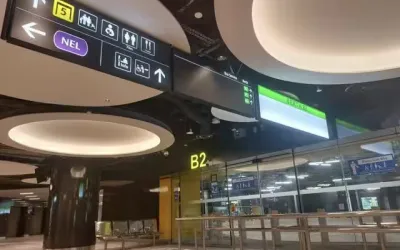2013年客工騷亂(圖片來自網絡)
受事件影響,新加坡政府採取了為客工建造宿舍的措施。2014年的政府文件中甚至有「如在宿舍附近設立價格合理的日用品店,客工就可以不需要離開宿舍區域、進入本地居民區(去購買生活用品)」這樣的記錄。似乎認為只要把客工和本地社群分得夠開,衝突就會減少。很多社會組織和醫療專家都曾對這個治標不治本的計劃提出異議,指出人員密集的宿舍將成為傳染病的溫床——而七年後的今天,擔憂變成了現實。
In December 2013, the government ordered the construction of additional worker dormitories after some 300 migrant workers rioted following the death of a fellow worker in a bus accident (the first instance of such unrest in 40 years). Neighborhood residents subsequently decried the behavior of migrant workers living in the area, prompting the government to build dormitories with more attached facilities so that workers would not have to venture into areas where Singaporeans live. 「Dormitory-based provision shops, especially if reasonably priced, could also encourage some workers to stay at their dormitory rather than travel out to a congregation area,」 said a 2014 investigative committee report. Now, seven years later, these dormitories have become epicenters of Singapore’s COVID-19 crisis, validating early - and unheeded - warnings from NGOs and healthcare experts that they can easily become hotbeds of transmission.
客工的宿舍生活?
How Do Migrant Workers Live?
在新加坡,大約三十萬名客工都住在宿舍里,一部分是專為他們設置的宿舍,還有一些是工地上的臨時宿舍。宿舍條件十分惡劣,空間小、不通風,而一般都會有十幾名客工擠在這樣的房間裡。由於宿舍里沒有配套廚房,客工們也沒有時間做飯,他們通常會買盒飯吃——工資的四分之一換來的是缺乏營養和衛生安全保障的飲食。辛苦而危險的工作加上糟糕的居住條件——幾乎令人難以想像在新加坡這樣一個發達的國家,還有人過著這樣的生活。
Approximately 300,000 migrant workers are split between Singapore’s 43 mega-dormitories, 1,200 factory-converted dormitories, and temporary living quarters on construction sites. Their rooms—which often house over ten people—are sometimes unsanitary and poorly ventilated. With neither kitchens nor time to cook, migrant workers pay a substantial amount of their salaries for catered food that is often spoiled and lacking in nutrients.

客工宿舍(圖片來自網絡)
值得慶幸的是,在疫情之下,客工面臨的這些問題終於開始受到重視,並且逐步得到改善。政府承認了自己的疏忽,越來越多的新加坡人也開始了解客工,並為他們的權益行動了起來。當然,偏見仍然存在。4月13日聯合早報(新加坡的主要中文報紙之一)上的一篇社論仍然將疫情的二次爆發歸咎於客工們不良的衛生習慣和生活習性。這篇文章隨即引起了軒然大波,新加坡內政部部長也直接站出來批評這種充滿偏見的言論。這樣強烈的社會反響體現出輿論的轉變:新加坡的主流社會已經不能接受狹隘的仇外心理。當然,輿論變化是否能夠帶來切實的行動仍然有待觀察。
Nevertheless, with greater social awareness and media coverage of their plight, the situation for migrant workers has started to improve. The government has acknowledged its initial oversight, and many sympathetic Singaporeans have been galvanized to help. Of course, prejudice still exists: for example, an April 13 letter to the Editor published in Zaobao, Singapore’s most popular Chinese-language daily newspaper, blamed the COVID-19 outbreak on migrant workers』 personal hygiene and cultural habits. However, the storm of criticism this incited, including comments from Minister for Home Affairs and Law K. Shanmugam, suggests that mainstream opinion no longer tolerates such xenophobia. Sentiment on the ground does indeed appear to be shifting, although whether this will last beyond the current crisis remains to be seen.

原本8人一間的客工宿舍,由於疫情改為3人一間(圖片來自網絡)

部分客工被疏散至更為寬敞的居住場所,例如圖中的軍營(圖片來自網絡)
客工,不單單是新加坡的問題
A Worldwide Problem
這次的疫情不僅給新加坡人上了重要的一課,也給其他許多存在客工問題的社會帶來了巨大的影響。在德國,東歐勞工工作的屠宰場由於衛生條件差和擁擠導致了上百人的疫情爆發(例:德國600多名屠宰場工人確診);在泰國,許多來自緬甸、寮國和柬埔寨的客工因疫情丟了工作又回不了家,陷入進退維谷的境地(例:泰國外籍勞工怎麼辦?);沙特和阿聯則直接遣返了大量來自衣索比亞的勞工(例:埃塞政府不再向中東的埃塞公民分發現金援助)。對於客工而言,他們既得不到外國政府的福利保障,也無法指望自己的國家能成為疫情之下的避風港;面對疫情,他們沒有工作、沒有補助、沒有社會的關心,孤立無援,束手無策。
Looking beyond Singapore, the COVID-19 pandemic has highlighted the plight of low-wage migrants around the world, many of whom lack basic rights, healthy living conditions, and access to quality healthcare. In Germany, cramped, squalid living quarters and overcrowded buses used to ferry workers might have contributed to the infection of hundreds of Eastern Europeans working in abattoirs. Countries like Saudi Arabia and the United Arab Emirates have deported Ethiopian workers by the thousands over COVID-19 concerns. In Thailand, thousands of migrant workers from neighboring Myanmar, Laos, and Cambodia found themselves stranded without employment or aid when the government closed all of its borders to inbound and outbound travel. Because most social welfare measures are linked to permanent places of residence, migrant workers could not access aid to purchase daily necessities. With no work or food, thousands walked home - sometimes more than 1000km. Many died of heat, hunger, fatigue, or road accidents.

圖片來自網絡
客工的問題同時也折射出了全球化的雙面性。客工現象是人力資本在全球化浪潮中重新配置的表現之一,這一群體為各國的經濟增長作出了巨大貢獻,卻並沒有享受到與其貢獻匹配的回報。客工遭遇的困境以及疫情的蔓延這類全球性挑戰對各國在全球化時代的治理提出了新的要求。希望這次疫情所激起的社會關注不會隨著時間又一次消失殆盡,也希望這種關注能夠促進社會各界加強對客工這一群體的了解和重視,促使決策者制定更加公平的勞工政策。
The migrant worker crisis also reflects globalization’s double-faced nature. The very existence of the migrant worker phenomenon is itself a result of the global redistribution of human capital, which has created communities that have made extraordinary contributions to the economic development of each country they appear in. However, many have not managed to reap the rewards of their sacrifices. The plight of migrant workers and the spread of the COVID-19 pandemic are interconnected global challenges that present new governance issues for all countries. We can only hope that the collective attention the pandemic has drawn to migrant worker communities will outlast the current crisis, and will result in a renewed commitment to ensure equitable treatment for those who build and maintain the very foundation that cities like Singapore stand upon.



